|
|
|
Sort Order |
|
|
|
Items / Page
|
|
|
|
|
|
|
| Srl | Item |
| 1 |
ID:
187138


|
|
|
|
|
| Summary/Abstract |
China is constructing an overwhelming satellite network, called the “National Spatial Infrastructure”, that might change the security and economic operations of global governance. Xi Jinping’s Military–Civil Fusion (MCF) strategy is founded on this system. Along with the well-known BeiDou Navigation Satellite System (BDS), the remote sensing satellite system and the communication and broadcasting satellite system form this new infrastructure. China is using it to establish a strong monitoring capability by: collecting various data on vessels’ navigation and oceanography; developing a huge communication network that covers actors and objects on the ocean as well as in the sky and the space; reforming its fishery administration and establishing new laws that enable the authorities to mobilise the numerous Chinese fishermen operating in global waters; and cultivating people-friendly apps to invite more users into the Chinese systems. Based on its strong victimhood mentality that calls for “great rejuvenation of the Chinese nation”, the Xi Jinping administration is trying to initiate a new human age by developing advanced technology and integrating it with social implementation that aims to increase China’s influence over the globe.
|
|
|
|
|
|
|
|
|
|
|
|
|
|
|
|
| 2 |
ID:
187137
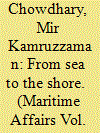

|
|
|
|
|
| Summary/Abstract |
When it comes to the maritime history of the Indian Ocean Region (IOR), there are few available textual resources and written pieces of evidence which can help undertake a cogent reconstruction. This article attempts to retrieve some of those maritime practices that prevailed among the mariners and sailors on the basis of a few available written documents, such as travellers’ accounts, Mughal court chronicles, European factory records and other written documents. Such historical reconstruction is important since, in the past few decades, the Indian Ocean has become significant object of study in its own right. The article seeks to recover “forgotten” oceanic histories of law or practices in the western IOR, and examine how these got institutionalised as admiralty law in India. More precisely, it focuses on the process of the transformation of maritime law from tradition to admiralty law in some detail.
|
|
|
|
|
|
|
|
|
|
|
|
|
|
|
|
| 3 |
ID:
187140
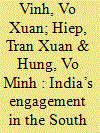

|
|
|
|
|
| Summary/Abstract |
The South China Sea is of immense strategic significance to India from politico-diplomatic, economic and security perspectives. As a rising power, India has expanded its strategic geography and, in this context, it formulated its Look East Policy, which was rechristened as the Act East Policy in 2014. Its current interests go beyond Southeast Asia into the wider Asia-Pacific region, including the South China Sea. From an economic perspective, more than 50% of India’s trade is transported through the sea lanes of the South China Sea. India is also concerned about China’s assertiveness here, in particular its aggressive posturing and militarisation of the disputed Spratly and Paracel Islands and non-adherence to the 1982 United Nations Convention on the Law of the Sea (UNCLOS). India has actively promoted the principles of international law and freedom of navigation and overflight in the South China Sea. Further, the Indian Navy has maintained a regular presence in the South China Sea to protect India’s economic and security interests, which includes the Oil and Natural Gas Corporation’s (ONGC) offshore oil and gas exploration project in partnership with Vietnam.
|
|
|
|
|
|
|
|
|
|
|
|
|
|
|
|
| 4 |
ID:
187141
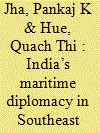

|
|
|
|
|
| Summary/Abstract |
India–Southeast Asia defence cooperation has not been highlighted much, primarily to not give out wrong signals about India’s power projection outlook. With India steadfastly maintaining that it is a benign nation and not a revisionist power, engagement in the defence domain with Association of Southeast Asian Nations (ASEAN) has been attempted in five ways. The first includes India’s engagement in ASEAN defence mechanisms, such as ASEAN Defence Ministers’ Meeting (ADMM) Plus; and the participation of ASEAN nations in the Milan series of biennial meetings and Indian Ocean Naval Symposium (IONS). The second dimension is India’s legitimate interest in the security of the Malacca Strait as a funnel state. The third dimension is developing synergies between the defence industries in Southeast Asia with the Indian defence industrial complex. The fourth angle of engagement is India’s position as the net security provider in the Indian Ocean Region (IOR). The fifth critical aspect is developing maritime cooperative mechanism and developing a counter to the Chinese “string of pearls” strategy.
|
|
|
|
|
|
|
|
|
|
|
|
|
|
|
|
| 5 |
ID:
187136
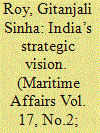

|
|
|
|
|
| Summary/Abstract |
K.M. Panikkar’s understanding of India’s strategic vision for the Indian Ocean highlighted the strategic dots of Socotra and Indonesia, which were a part of a larger game plan of a “strategic arc”. His idea of Socotra and Indonesia was based on the linkage between the two strategic sea lanes of communication. In the present context, Panikkar’s strategic arc has been readopted in Prime Minister Narendra Modi’s new vision, which aims to pave the way for India to engage in friendly ports so as to create a network of strategic ports for defence and civilian purposes. This article endeavours to understand Panikkar’s “strategic arc”, traced from the east coast of Africa to the island of Sumatra. Further, it analyses how Panikkar’s strategic arc has been realigned and reinvigorated in the present scenario from Oman to the islands of Indonesia, which helps in furthering India’s economic interests as well as protect its strategic well-being. The article concludes by offering a set of policy recommendations based on Panikkar’s strategic arc and how these could be inculcated within the larger framework on India’s security and maritime policy.
|
|
|
|
|
|
|
|
|
|
|
|
|
|
|
|
| 6 |
ID:
187144
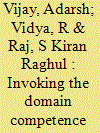

|
|
|
|
|
| Summary/Abstract |
India’s growing role as a maritime powerhouse beckons unprecedented opportunities and challenges. The present mode of maritime governance characterised by the outdated role of generalists, particularly the Indian Administrative Service (IAS), is nothing more than an unfaded representation of a colonial stopgap arrangement with no scientific substance per se. Irrespective of an ideation that took place in 2014, the Indian Maritime Service (IMS) as a technocratic cadre for maritime administration never came to fruition. The commentary builds a rationale for IMS as a non-uniformed branch of specialists in view of the highly technical frontiers of civilian maritime domain, which is left in the hands of generalists. It concludes with the requirement of recalibrating the civil services with sub-specialist credentials to enhance the Indian maritime trajectories.
|
|
|
|
|
|
|
|
|
|
|
|
|
|
|
|
| 7 |
ID:
187139


|
|
|
|
|
| Summary/Abstract |
The article explains how Japan's strategic interests are converging with India against an assertive China in the Indo-Pacific. Japan has been pursuing a “Free and Open Indo-Pacific” (FOIP) policy, which seeks to manage China's rise by deepening Japan's strategic coordination and cooperation with its closest partners through the Quad. Though Japan still values its bilateral relationship with the United States (US), its security partnership with India is part of Tokyo's persistent efforts to support the US-led rules-based international order. In order to counter China's Belt and Road Initiative (BRI) in the Indo-Pacific region, Japan has been a strong supporter among the Quad to promote non-military cooperation, primarily focusing on infrastructure building, supply chain resilience and technological innovations. The article argues that Japan's strategic engagement with India is now an integral part of its wider national security posture as Tokyo has come to recognise New Delhi as an important balancer against Beijing. That the US has enhanced its ties with India in recent years has further facilitated Japan–India strategic convergence since it is aligned with American policy towards the Indo-Pacific region in an era of great power competition.
|
|
|
|
|
|
|
|
|
|
|
|
|
|
|
|
| 8 |
ID:
187143
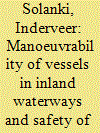

|
|
|
|
|
| Summary/Abstract |
A green and sustainable mode of transport, the inland waterway transport in India will see accelerated growth with the new Inland Vessels Act, 2021. This increased traffic growth in restricted waters will lead to economic, environmental, and safety challenges. Good manoeuvrability of inland vessels is critical to resolve these concerns. The world over, inefficient manoeuvring has resulted in several incidents which have affected the safety of navigation and maritime trade. Manoeuvrability of seagoing vessels must meet the minimum standards as per International Maritime Organization (IMO) Resolution MSC.137(76) and the MEPC1/Circ850/Rev.3 guidelines. In comparison, only a few countries, river commissions, and classification societies have specified criteria for navigation tests for inland vessels, and this does not include India. Manoeuvrability criteria and results of the tests are essential to facilitate the safe movement of vessels. This article discusses the results of full-scale manoeuvrability tests of inland vessels conducted by the author on India's national waterways and the Indo-Bangladesh Protocol route. It proposes manoeuvrability criteria for inland vessels plying in the inland waterways of India, including cross-regional protocol routes. The article also recommends measures to improve the safety of navigation in inland waters.
|
|
|
|
|
|
|
|
|
|
|
|
|
|
|
|
| 9 |
ID:
187142


|
|
|
|
|
| Summary/Abstract |
Seaports are an indispensable asset in interconnected and interdependent global supply chains. Their complex infrastructural and operational systems and critical foreland and hinterland networks make ports a vital nodal point in the economic progress of nations at large, and the coastal urban agglomerations in particular. These critical maritime assets are currently under threat from the disruptive impacts of anthropogenic climate change, such as sea-level rise and intensifying extreme weather events. The economic losses from these impacts will span a wide range, from hard infrastructural damages to operational delays in supply chain management. Incorporating climate resilience in existing and new port infrastructure remains a complex challenge that will require port authorities to confront the problem of climate uncertainty and its socio-economic implications. This article focuses on seaports in the Indian context to highlight the complex threats of climate change. It examines the main debates on climate uncertainty and policymaking, path dependencies in port planning, global best practices, knowledge gaps and strategies that will be critical for Indian ports to better confront climate change induced disruptions in the near future.
|
|
|
|
|
|
|
|
|
|
|
|
|
|
|
|
|
|
|
|
|